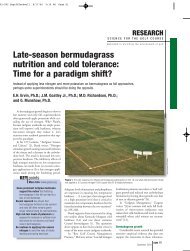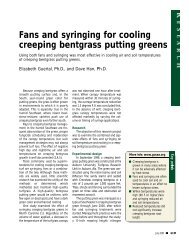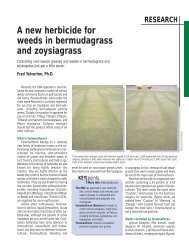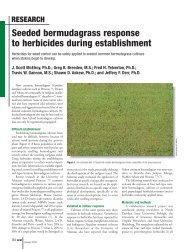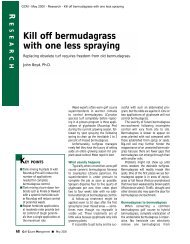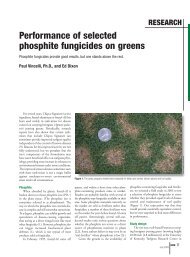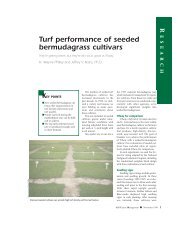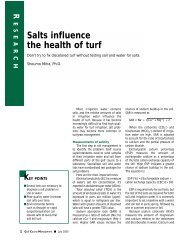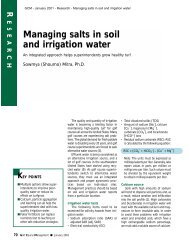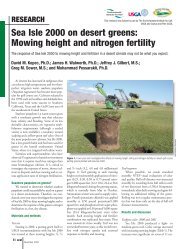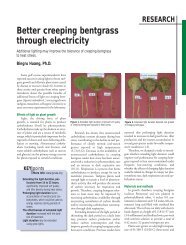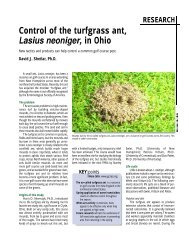A new Strobilurin fungicide for turfgrass disease control - GCSAA
A new Strobilurin fungicide for turfgrass disease control - GCSAA
A new Strobilurin fungicide for turfgrass disease control - GCSAA
You also want an ePaper? Increase the reach of your titles
YUMPU automatically turns print PDFs into web optimized ePapers that Google loves.
RESEARCHing and have other favorable characteristics.Insignia is highly toxic to fish and aquatici n ve rtebrates, but low use rates, rapid soildegradation and its strong adsorption to soilshould minimize risk if it is used pro p e r l y.Among other things, proper usage meansp re venting runoff and spray drift from comingin contact with bodies of water.Physical modes of actionTra n s p o rted in xy l e mPhysical modes of action differ in stro b i l-urin <strong>fungicide</strong>s. Azox y s t robin is xylem-mobile.R a d i o a c t i ve labeling experiments have clearlys h own that the <strong>fungicide</strong> moves acropetally inthe xylem and provides <strong>disease</strong> <strong>control</strong> fro mthe point of application upw a rd in the xylems t ream. T h e re f o re, if the <strong>fungicide</strong> is in a leafaxil, it will protect the entire leaf in a shorttime by absorption and translocation in thexylem. Likewise, if absorbed through the ro o tsystem, it can move within the xylem and protectroots as well as foliage. Azox y s t robin isgradually taken into plant surfaces, with 3 to25 percent taken into the plant more than 24hours after application. This concentration isenough to provide <strong>disease</strong> contro l .Azox y s t robin also provides prolonged contro lGRAY LEAF SPOT, PERENNIALRYEGRASSFungicide treatments in ounces/1,000 square feet■ Insignia, 0.5 ■ Insignia, 0.9 ■ Heritage, 0.2■ Compass,0.2 ■ Daconil Ultrex,3.2100of certain other <strong>disease</strong>s, such as brown patch(R h i zoctonia solani) .This is similar to the movement of DMI<strong>fungicide</strong>s within plants. Hence, DMI <strong>fungicide</strong>s,as well as azox y s t robin, have been ve ryuseful <strong>for</strong> <strong>control</strong> of ro o t - rot <strong>disease</strong>s, such assummer patch (caused by Ma g n a p o rt h ep o a e) and take-all patch (caused byGa e u m a n n o m yces gra m i n i s va r. a ve n a e) .Mesostemic actionTr i f l ox y s t robin is not transported in thexylem. Instead, the physical mode of action hasbeen described as m e s o s t e m i . cThis is analogousto local penetrant movement of dicarbox a m-ide <strong>fungicide</strong>s, such as iprodione (Chipco26019) or vinclozolin (Curalan and others).Yet, triflox y s t robin is different because thematerial breaks down into four fractions thatva ry in mobility around the site of application.One fraction is strongly attracted to lipids andbinds to the cuticle and wax layer of leave s .Another fraction can move by surface moistureand vapor activity and can be re d i s t r i b u t e da round the point of application and beyo n d .Yet another fraction can move across the leafblade, providing <strong>disease</strong> <strong>control</strong> on the oppositeside of the leaf from the application point.SUMMER PATCH100The mesostemic movement of triflox y s t ro b i nwas described in a 1999 G C M a rticle byA g n ew (1).Lipophilic pro p e rt i e sLike triflox y s t robin, pyraclostrobin, thea c t i ve ingredient in Insignia, is not transpo rted in the xylem. Howe ve r, pyraclostro b i nis most strongly lipophilic, or attracted tow a xes on and within the leaf. Ac c o rding toB A S F, pyraclostrobin penetrates the leafwithin minutes of application and is store dprimarily in the waxes of the leaf cuticle. T h i sp ro p e rty allows Insignia to be rainfast twohours after application. Because of the highlipophilic pro p e rties and quick local penetrationof pyraclostrobin, thorough coverage inapplication is ve ry important. The same ist rue <strong>for</strong> triflox y s t robin. T h o rough coverage isnot as important with azox y s t robin because ofits xylem mobility and because rain re d i s-tributes <strong>fungicide</strong> residues that have not ye tbeen absorbed within the plant. In general,t h o rough coverage in spray applications is ave ry good practice, re g a rdless of the <strong>fungicide</strong>.Biochemical mode of actionHeritage, Compass and Insignia all workFungicide treatments in ounces/1,000 square feet■ Insignia,0.5 ■ Insignia, 0.9 ■ Heritage, 0.2■ Heritage, 0.4 ■ Cleary 3336, 8.09590858075706560All treatments were applied at 14-day intervals except <strong>for</strong> the 0.9 ounce Insigniatreatment.Data are derived from three trials.908070605040All treatments were applied at 14-day intervals except <strong>for</strong> the 0.9-ounce Insignia and0.4-ounce Heritage treatments, which were applied at 28-day intervals. Data aretaken from Majumdar et al.in Fungicide and Nematicide Tests, vol.55,p.513.
y inhibiting cellular respiration, that is, bystopping the energy production within thefungal cells. T h e re f o re, spores that areundergoing germination or that otherwiserequire high amounts of energy (<strong>for</strong> example,swimming zoospores of Pythium) arequickly killed.These <strong>fungicide</strong>s all bind to the Q o site ofc y t o c h rome b, which is a site of the re s p i r a t i o nc y t o c h rome bc1 complex on the outside of themitochondrial membrane. (The mitochondriaa re the energy-producing organelles withincells.) This is important in the case of <strong>fungicide</strong>resistance. All three <strong>fungicide</strong>s have identicalbiochemical modes of action and there f o rebelong to the Q o I cro s s - resistance gro u p.It should be noted that some <strong>fungicide</strong>sh a ve chemical stru c t u res that do not re s e m-ble those of strobilurins, yet inhibit fungi inexactly the same way. Two such <strong>fungicide</strong>s aref a m oxadone, developed by Du Pont, andfenamidone, developed by Aventis; they arec u r rently not used as <strong>fungicide</strong>s. They alsobelong in the Q o I cro s s - resistance gro u p.This means that a pathogen population thatResistance Action Committee (FRAC) re c-ommends that, <strong>for</strong> all <strong>disease</strong>s, these <strong>fungicide</strong>sbe applied pre ve n t i vely or early in the stages offungal development be<strong>for</strong>e infection. Fo rgray leaf spot and anthracnose, where re s i s-tance is a high risk, do not apply sequential(back-to-back) applications of stro b i l u r i n<strong>fungicide</strong>s. For other <strong>disease</strong>s where re s i s t a n c ehas not been detected, apply no more than twosequential applications of strobilurin <strong>fungicide</strong>s,rotate with <strong>fungicide</strong>s that have a multisitemode of action whenever appropriate anduse best cultural practices to minimize <strong>disease</strong>p re s s u re. Fo l l ow the current labeling suggestionsof these <strong>fungicide</strong>s re g a rding maximumuse rates in a yearly season.Effectiveness of InsigniaBrown patch and dollar spotEven though resistance is a ve ry import a n tissue, these <strong>fungicide</strong>s have proven ve ry effecti ve <strong>for</strong> excellent <strong>control</strong> of many <strong>turfgrass</strong> <strong>disease</strong>s.Insignia is effective against many of themajor <strong>turfgrass</strong> <strong>disease</strong>s at label rates of 0.5 to0.9 ounce of product/1,000 square feet <strong>for</strong> 14RESEARCHAn t h racnose and gray leaf spotInsignia is also effective against anthracnose,although resistance most likely will be ani m p o rtant issue with this <strong>disease</strong>. The same ist rue <strong>for</strong> gray leaf spot <strong>control</strong>. The data show n<strong>for</strong> gray leaf spot <strong>control</strong> we re derived fro mt h ree trials, be<strong>for</strong>e the development of re s i s t a n c ein some sites with gray leaf spot in perennial ryegrass.It is too early to determine how In s i g n i awill per<strong>for</strong>m in sites with confirmed re s i s t a n c eto azox y s t robin and triflox y s t robin, but, consideringcro s s - resistance, effectiveness will bereduced compared to <strong>control</strong> of sensitivestrains of Pyricularia grisea.Pythium blight and summer patchInsignia is also active <strong>for</strong> Pythium blightc o n t rol. Because it belongs to a different biochemicalmode of action, Insignia is effectiveagainst Py t h i u mpopulations with resistance tometalaxyl and mefanoxam, providing anothertool in those cases. In t e re s t i n g l y, although the<strong>fungicide</strong> apparently is not mobile within ro o tsystems, it has effectively <strong>control</strong>led summerpatch at higher rates of use.TURFGRASS DISEASES EFFECTIVELYCONTROLLED BY INSIGNIAAnthracnoseBentgrass dead spotBrown patchDollar spot (suppression)Fairy ringFusarium patchGray leaf spotGray snow moldis resistant to one <strong>fungicide</strong> within the Q o Ic ro s s - resistance group will be resistant to allothers within that gro u p.Resistance to azox y s t robin and triflox y s-t robin has been confirmed in populations ofPyricularia grisea, the causal agent of gray leafspot, as well as Colletotrichum gra m i n i c o l a, thecausal agent of anthracnose. One case of re s i s-tance to Pythium aphaniderm a t u m, a cause ofPythium blight, has also been confirmed. Ons e veral golf courses, this resistance has led to thecomplete failure of these <strong>fungicide</strong>s <strong>for</strong> contro lof these <strong>disease</strong>s. T h e re f o re, it is extre m e l yi m p o rtant that resistance be managed pro p e r l y<strong>for</strong> the strobilurins and other <strong>fungicide</strong>s in theQ o I cro s s - resistance gro u p.Cu r re n t l y, the industry-led Fu n g i c i d eLeaf spots and melting outPink patchPink snow moldPythium blightRed threadRustSummer patchTake-all patchto 28 days. Ef f e c t i veness differs among these<strong>disease</strong>s, but several unique characteristicsapply to Insignia. Although it is not mobile inthe xylem, it still exhibits excellent brow npatch <strong>control</strong>. It is also the first stro b i l u r i nlabeled <strong>for</strong> <strong>turfgrass</strong> that has at least somee f f e c t i ve activity against dollar spot.Ef f e c t i veness against dollar spot appears to last<strong>for</strong> 14 days, but <strong>disease</strong> <strong>control</strong> is lost whenInsignia is applied at higher rates and longeri n t e rvals (0.9 ounce/1,000 square feet, 28days). Howe ve r, if Insignia is not rotated witha different, effective dollar spot <strong>fungicide</strong>, thendollar spot can resurge in sites pre v i o u s l yt reated with Insignia. Similar <strong>disease</strong> re s u r-gence phenomena have been documentedwith Compass, Heritage and Pro s t a r.Mo re to learnMuch remains to be learned about all thes t robilurin <strong>fungicide</strong>s. Regional re s e a rch isneeded to determine how best to deploy them<strong>for</strong> most effective <strong>disease</strong> <strong>control</strong> and to avo i dor prolong the development of resistance insome pathogen populations. Howe ve r, these<strong>fungicide</strong>s clearly are valuable tools <strong>for</strong> <strong>turfgrass</strong><strong>disease</strong> contro l .A c k n o w l e d g m e n t sI thank researchers from the University of Georgi a ,C l e m s o nU n i v e r s i ,University t y of Mary l a n d ,Rutgers University and V i r gi n i aTech <strong>for</strong> providing data <strong>for</strong> <strong>disease</strong> <strong>control</strong> including Insignia.Some funding <strong>for</strong> this research was provided by BASF.References1. Ag<strong>new</strong>, M.1999.Fungicide fuses to grassblades. Golf Course Management 67(7):72-75.2. American Phytopathological Society. 2000-2001.Fungicide and nematicide tests. Volumes 55-56.3. B a r t l e t t ,D.,J. M . C l o u g h ,J. G o d w i n ,A. H a l l ,M.H a m e rand B. Pa r r- D o b r a n s k i .2002.R e v i e w The : strobilurinf u n g i c i d e s .Pest Management Science 58 : 649 - 662 .4. Couch,H.B.1995.Diseases of <strong>turfgrass</strong>es,3rdedition.Krieger Publishing,Malabar, Fla.5. Vincelli, P.,and E.Dixon.2002.Resistance to Q o I(strobilurin-like) <strong>fungicide</strong>s in isolates ofPyricularia grisea from perennial ryegrass. PlantDisease 86:235-240.Bruce Martin,Ph.D.(sbmrtn@clemson.edu),is a professorat Clemson University’s Pee Dee Research andEducation Center in Florence, S.C.



